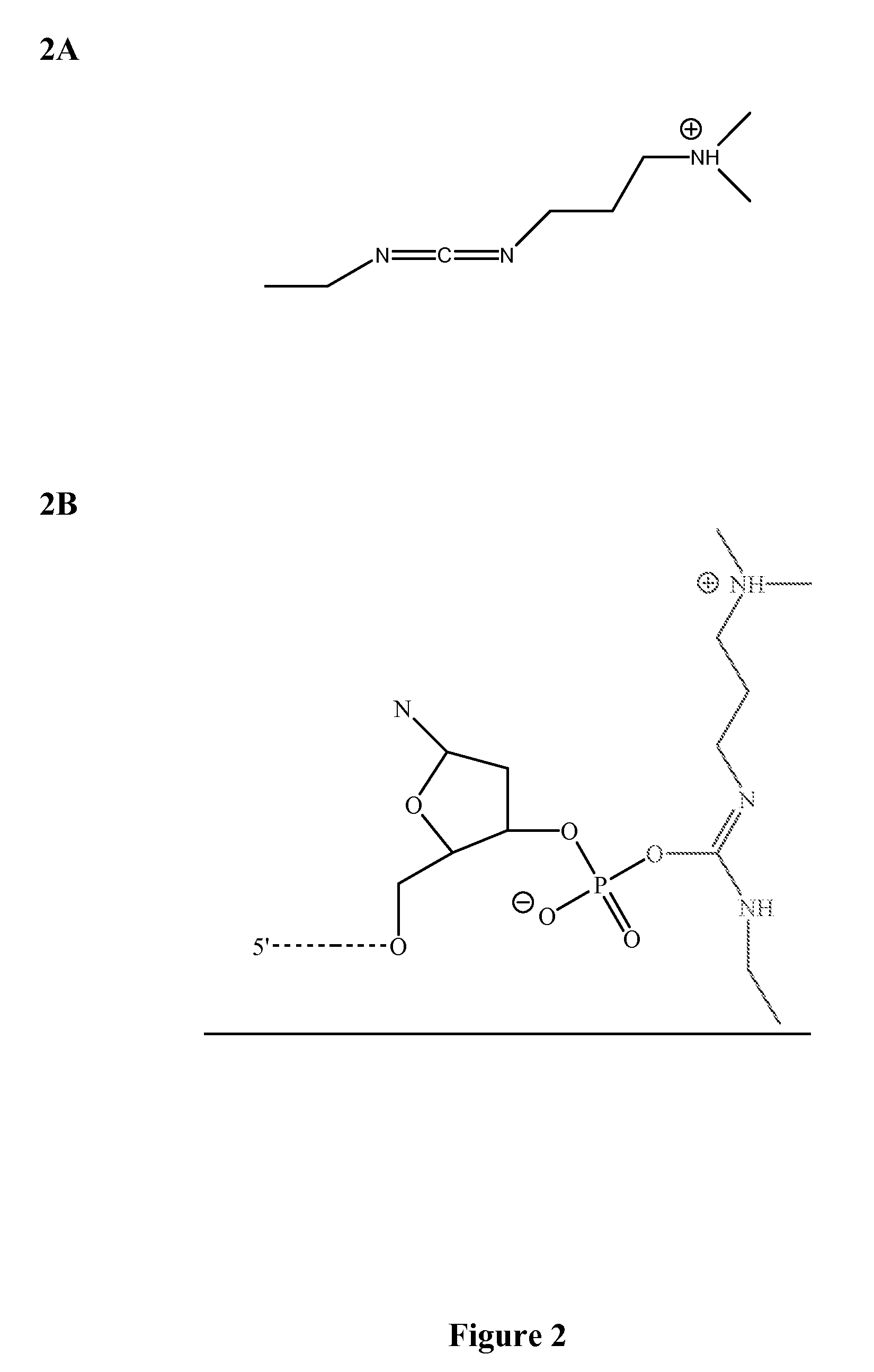Methods and Compounds For Chemical Ligation
a nucleic acid and chemical ligation technology, applied in the field of compounds and methods for chemical ligation nucleic acids, can solve the problems of damage to the dna template to be sequenced after, too slow to be useful,
- Summary
- Abstract
- Description
- Claims
- Application Information
AI Technical Summary
Benefits of technology
Problems solved by technology
Method used
Image
Examples
example i
Four Classes of Fast, Accurate Chemical Reactions
[0049]Four classes of fast and accurate chemical reactions have been identified: 1) cyanogen bromide-based reactions; 2) carbodiimide-based reactions; 3) amidate-based reactions; and 4) phosphodiester mimetic-based reactions. These classes are suitable for use in a variety of methods that can utilize ligations including, but not limited to, sequencing by chemical ligation, synthesis of oligonucleotide sequences and assembly of oligonucleotide sequences.
[0050]Cyanogen bromide-based reactions (FIG. 1) and carbodiimide-based reactions (FIG. 2) were used to perform sequencing by ligation reactions. The reactions proceeded in a very fast manner (i.e., on the order of a few seconds). The reaction rate was limited only by hybridization kinetics in a complex mixture of 6-mer to 9-mer oligonucleotide sequences. Cyanogen bromide-based and carbodiimide-based chemical ligation reactions are depicted in FIG. 4. Amidate-based reactions and compound...
example ii
Phosphodiester Mimetics
[0051]Phosphodiester mimetics, e.g. aldehydes generated by periodate, Schiff's base intermediates formed on reaction with primary amines and the like, are depicted in FIG. 7. The chemical ligation reactions have a broader range of substrates so that the variation in binding as a function of template, anchor and probe can be altered, for example, as depicted in FIG. 8. Certain mimetics may also be suitable for protein-ligase or polymerase reactions.
[0052]The probe can substitute one or more T to S2T, which binds better to A (higher Tm) on the template strand. Similarly, one or more A's in the probe can be replaced by diaminopurine (DAP) which binds better to T on the template strand. Due to its bulk and lowered hydrogen-bonding ability, the S2T is also better at discriminating against G or DAP in the probe molecules or G in the template molecules (James et al. (1997) Chem. Biol. 4:595).
example iii
Preactivated Phosphates
[0053]In certain exemplary embodiments, preactivated phosphates are used to accelerate ligation reactions. Preactivated phosphates can be present on, for example, one or more of the 3′ and / or 5′ ends of an oligonucleotide sequence. If the oligonucleotide sequence has preactivated phosphates at both ends, this permits a second round of ligation (e.g., sequencing by chemical ligation) without need for a potentially inefficient deprotection step. The second round probe would have a non-phosphate OH, SH or NH2 moiety at its 5′ end if the original anchor is on the 5′ end, and / or a non-phosphate OH, SH or NH2 moiety at its 3′ end of the second probe if the original anchor is to the 3′ end of the template region to be sequenced. Without intending to be bound by scientific theory, an oligonucleotide sequence having two non-phosphate ends could serve this purpose as well. FIGS. 5A-5B schematically depict chemical ligation using preactivated phosphates. Ligation using o...
PUM
| Property | Measurement | Unit |
|---|---|---|
| temperature | aaaaa | aaaaa |
| temperatures | aaaaa | aaaaa |
| temperatures | aaaaa | aaaaa |
Abstract
Description
Claims
Application Information
 Login to View More
Login to View More - R&D
- Intellectual Property
- Life Sciences
- Materials
- Tech Scout
- Unparalleled Data Quality
- Higher Quality Content
- 60% Fewer Hallucinations
Browse by: Latest US Patents, China's latest patents, Technical Efficacy Thesaurus, Application Domain, Technology Topic, Popular Technical Reports.
© 2025 PatSnap. All rights reserved.Legal|Privacy policy|Modern Slavery Act Transparency Statement|Sitemap|About US| Contact US: help@patsnap.com



